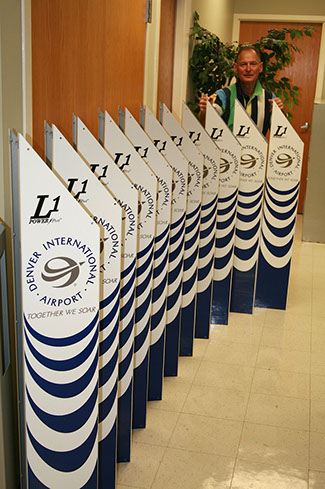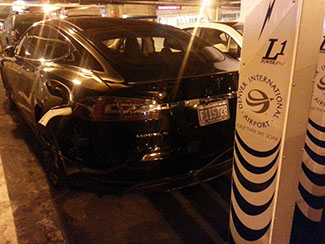
Konnectronix bets on Level 1 commercial charging stations
As seen in Charged Magazine, February 2014
While most of the discussion about commercial EVSE seems to revolve around peoples’ desire for ever-faster charging, Konnectronix has taken the opposite approach, producing what is designed to be the first true commercial Level 1 charging station on the market. Like many another great idea, the inspiration for the L1 PowerPost came as a serendipitous observation in the course of developing a different product.
Konnectronix has a long history in the aviation business, making retractable cord reels and other electronic products. If you’ve ever pulled the phone out of the armrest on an airplane, you’ve used one of Konnectronix’s retractable cord reels.
Two years ago, Allen Will, the company’s Director of Business Development, saw a need in the EV charging marketplace for a retractable cord reel, so Konnectronix designed a reel for a Level 2 charging station. After that product was designed and prototyped, it occurred to Will that there was a greater need for commercial Level 1 charging station products. He realized that many charging station users are parking their cars all day – at work, for example – so their vehicles are charged within a couple of hours, and a more costly Level 2 charger may sit idle for the rest of the day.
One of the first orders was for the Denver International Airport. “Airports are a perfect location for commercial Level 1 – most people are parked at the airport for at least a day. Those stations are, in fact, being used quite a bit. They installed ten units and now report consistently high usage.”


With this in mind, Konnectronix developed the L1 PowerPost, a commercial Level 1 charging station with a heavy-duty retractable cord reel. It’s designed to be a low-cost, simple and easy-to-use piece of equipment that meets the needs of people who are parked for half a day or more.
One of the first orders was for the Denver International Airport. “Airports are a perfect location for commercial Level 1 – most people are parked at the airport for at least a day. Those stations are, in fact, being used quite a bit. They installed ten units and now report consistently high usage.”
More orders from universities and workplaces followed. At the time, Level 1 wasn’t covered by any of the state and federal programs that offer incentives for installing commercial chargers. Konnectronix became active in the Illinois EV Advisory Council, and worked with the state of Illinois to include Level 1 commercial charging stations in its incentive program, which offers a fifty percent rebate, with a cap of $7,500.
For installations where Level 1 charging is appropriate, the cost savings versus Level 2 are significant. Level 2 chargers can cost up to $6,000 per unit, but the L1 PowerPost is priced at $1,495.
Ongoing electricity costs are also a factor. “Many facilities are billed for electricity based on their peak energy demands. If you’ve got enough Level 2 units at 30 or 40 amps each, that could add just enough to the peak energy demand to boost the facility into another electric rate bracket. Most people don’t travel much more than twenty miles each way to get to work, and that can easily be recovered with the Level 1 unit in four or five hours. Even if you go thirty miles, you can recover that in the eight hours that you’re in your office. It spreads out that energy use quite nicely, without the risk of being pushed into a higher electricity rate.”
Konnectronix’s rugged retractable cord reels are another selling point. Denver International’s RFP mentioned its concern about cords lying on the ground, which could trip people, or be damaged.
A skeptic might ask, “Why not just install some 120-volt outlets?” However, a standard electrical receptacle isn’t designed for EV drivers to be plugging in and out several times a day. “If you check into the UL testing of an outlet, they only test receptacles for about 50 cycles. Secondly, you’re going to have people with EVs plugging in their cord set, which presents a theft risk. That cord set, as you know, is expensive; it’s at least $400 to replace.”
“The retractable cord reel made by Konnectronix is not at all like a cord reel you may purchase at your local hardware store – such as a trouble light. Typical consumer cord reels have brushes and slip rings. The one made by Konnectronix has a continuous electrical connection from end to end. As a result, there’s no possibility of sparking or arcing. It is also completely waterproof. UL tested it to 6,000 cycles, but Konnectronix engineering tests have exceeded 20,000 cycles. We expect that cord reel to last for the life of the unit.”
“At Denver International, they looked at the cost of the electricity, and found that it’s typically less than a dollar a day, so they decided not to charge people for that and make it part of the overall parking experience. A lot of corporate parking lots are looking at the same thing. The reason is the energy costs are quite minimal, but the equipment to try and collect money – credit card readers and RFID and all the other types of devices – adds cost and complexity.
Often, when a charging unit is down, it’s not because of the actual charging components, but because of the communication or revenue-collecting devices that are in it. Our approach was to keep this as simple as possible, but we are working on low-cost, optional modules for networking, metering and payment if a customer truly needs that functionality. There are a lot of potential customers that are interested in knowing when, as well as how much energy was used.”
One issue that the charging industry is closely following is the question of whether the IRS is going to decide that workplace charging constitutes a taxable benefit. “We’re not sure how that’s going to play out because, again, the cost of the energy that’s used is less than the cost of a cup of coffee, and coffee at the office is not an IRS issue,” explained Allen Will. “When you have an EV, you learn quickly what electricity costs. For example, at my house, I’m paying maybe 30 to 40 cents an hour for electricity. I love to plug in when it’s available, but some of the costs to charge in public are often 4 or 5 times what I pay at home. Everybody who drives a gasoline car knows about miles per gallon and what a gallon of gas costs. To change your thinking to miles per kilowatt-hour happens pretty quickly – the math is simple.”
If the IRS eventually requires traceability and reporting, then “Konnectronix will make sure that the L1 PowerPost complies with all future needs,” said Will. “But we will always stay true to a simple, robust, and economically viable product.”
View the original article here >
Copyright © 2022 Konnectronix, Inc. All rights reserved. For a complete Konnectronix patent and trademark listing, please visit our legal page.
2340 Ernie Krueger Circle Waukegan, IL 60087 847-672-8685